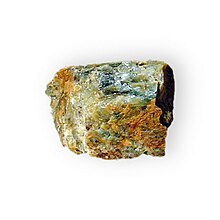Lime silicate rock
Lime silicate rock is the name of a metamorphic rock that was created from marly sedimentary rock through the reaction of calcium and silicon . Since the mixing ratio of calcite and clay minerals in marls can be very different and the minerals formed during metamorphosis react to further pressure and temperature changes, with new minerals being created, the composition of the calcareous silicate rocks is very variable. Changes in the mineralogical composition in the parent rock lead to a banding of the calcium silicate rocks, which reflects the original stratification. As far as the minerals in the rock unregulated exist, the name is lime silicate rock used the rock, however, shows a engständiges structure of divisions, it is considered Kalksilikatgneis referred.
composition
Typical minerals of calcareous silicate rocks are calcite or dolomite , quartz , a calcium-rich plagioclase , epidote , garnet (from the grossular - andradite mixed series), Vesuvian , tremolite , diopside and wollastonite . Titanite often occurs in small quantities . In iron - and magnesium-rich parent materials, however, are more likely hornblende , Grenade from the almandine - pyrope -Mischreihe, forsterite , prehnite , Pumpellyite , minerals of the serpentine group and talk to find.
For each mineralogical composition in addition to the chemical composition of the parent material of the pressure prevailing during the metamorphosis pressure , the temperature and the CO 2 - partial pressure significantly. Experimental work on mineral mixtures at the beginning of the 1970s determined the exact pressure and temperature conditions for the reaction of minerals in calcium silicate rocks, which made it possible to draw conclusions from the mineral parageneses found in calcium silicate rocks, inversely, about the pressures and temperatures prevailing during the metamorphosis.
Occurrence and use
The rock occurs worldwide both in the deeply eroded basement of old cratons and in contact aureoles around more recent intrusions . In the German-speaking countries, occurrences in the Black Forest , the Bavarian Forest or the Central Alps are known. Lime silicate rocks are easy to grind and polish and are suitable as floor or wall cladding in interiors. Well-known trade names are Lapponia Green ( Finland ) and Cipollino ( Italy ).
Individual evidence
- ^ Myron G. Best: Igneous and Metamorphic Petrology. WH Freeman & Co., New York 1982, pp. 384/385 ISBN 0-7167-1335-7
- ^ Helmut GF Winkler: Petrogenesis of Metamorphic Rocks. 5th ed., Springer-Verlag, New York, Heidelberg, Berlin 1979, pp. 111-128
- ↑ Dale, J., Holland, T. & Powell, R. (2000) Hornblende – garnet – plagioclase thermobarometry: a natural assemblage calibration of the thermodynamics of hornblende. Contrib. Mineral. Petrol. 140 (3), 353-362
literature
Wolfhard Wimmenauer : Petrography of igneous and metamorphic rocks. Stuttgart: Enke, 1985, pp. 301-303. ISBN 3-432-94671-6
